Having noticed a few different hardware retailers and grocery shops making moves into the home battery market, it seems prudent to point out the pitfalls of cheap small systems.
Recently we detailed why bigger isn’t always better, but this time around I’d like to explain how we arrive at just right.
If your hip pocket nerve is the most reactive of your senses, I’d suggest taking the fingers you use to count your savings and slamming them in the car door. The pain will be a great way to focus attention, and you’ll realise paying for a replacement battery is difficult when you’re smarting from a self-inflicted injury.
Now I appreciate that might sound a little extreme but it’s a necessary evil, genuinely proportional to the problem.
You see in the SolarQuotes office we often field phone enquiries from people who have multiple quotes in hand. They ask advice on what is the best solution and you can hear the pleading in their voice, surely the cheap quote for a small 5kWh battery can’t be that bad?
Small Batteries Suit Very Small Users
The most modest bachelor I ever met, with a gas hot water service and a habit of watching TV under a blanket without the lights turned on, still used about 8 kWh per day on average. While solar would have knocked that consumption down considerably, a 5kWh battery would barely run his fridge and freezer.
I’m not saying it wouldn’t help out, cycled twice a day using a cheap off-peak retail plan, it would work hard and make a decent return on investment, I expect.
However the average Australian house uses double or triple that amount of energy, so there’s every chance a 5kWh battery would be flat by tea time, before the telly even goes on.
Little Power And Few Hours
A 5kW inverter and oversized 50kWh battery is a poor choice. A 5kW inverter and undersized 5kWh battery is arguably worse.
If there’s a grid outage, your inverter needs a decent reserve of energy on tap to meet peak loads like starting the fridge. Many have exceptions and can work with a minimum 6kWh, but doesn’t have advertised surge capacity; unless you have a larger battery of say 9 or 12kWh stacked behind them.
Sadly most batteries don’t specify a “C-rate” which explains the speed at which you can get power into or out of them, however some are honest enough to give you a simpler explanation. Tesla Powerwall 3 for instance can charge at 5kW and discharge at 10kW.
While Powerwall 3 has a very useful 13½kWh sized tank, a cheap 5kWh solution from the centre aisle will likely be a big disappointment. You would have to be an exceptionally modest energy user to cook your tea, run some heating or cooling through the night and then manage the morning coffee without importing expensive electricity.
Still, running a midnight recharge scenario might work, if the cheap hardware can automate it. To be honest the network providers and energy retailers would probably find that suits them the best.
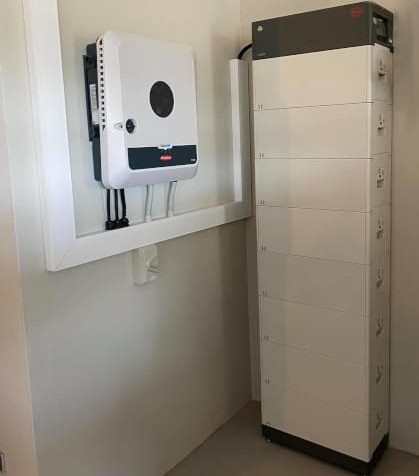
This beautifully executed Fronius shows battery stacks can grow tall, so it’s best for the inverter to go beside them. Image credit Jae Taylor
Bottom Line Is Careful Design
People qualified to design and install batteries have been trained to size them correctly, not just shop for perceived bargains.
It’s why the industry would like to see sales companies ruled out unless they have trained staff. And it’s also why sometimes the people installing on the day find a fatal technical flaw in the sales process is hidden behind the switchboard, where only electricians can legally poke their fingers.
There’s a lot more to a solar power system and a home battery than just the invoiced cost. If you get the design wrong, not only will it be a waste of money, it’ll be a waste of time installing it.
More importantly it will be a waste of your Cheaper Home Battery Program rebate, which a household only gets to claim once.
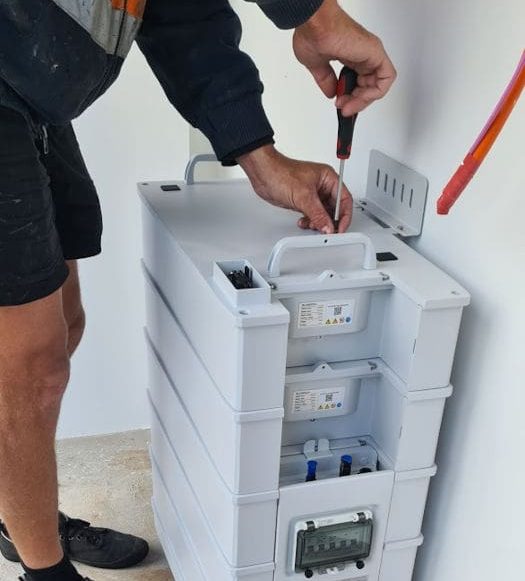
Even if you started out with a small modular battery that can be upgraded to a larger capacity in future, that upgrade would miss out on the rebate.
Cheaper Doesn’t Mean Cheapest
The federal government has introduced the rebate to make batteries cheaper, not cheapest.
The guidance you need to follow isn’t so much the brand name of the scheme, but what it says on the back of the tin. The feds are offering to pay for about one third of your battery, so for every 1kWh of storage capacity you buy, they’ll kick in about $350.
Think of it like buying a car, from a recognised dealer who obviously has a service department and offers warranty support from a recognised international company. If you have a list price for a new vehicle and the government is offering genuine 30% discount, that’s a great deal.
If you buy a cheap battery, and it dies an early death, that’s poor value for my taxpayer dollar. It’s worth asking if you can afford to burn your initial investment; can you afford to spend twice as much again for a decent quality replacement?
Early Adopters Are A Cautionary Tale
I’ve had first hand experience with people at the leading edge of technology adoption, those who will spend irrational sums, because they just want the latest thing.
These energy enthusiasts were a pain in the arse from a retail solar perspective, but they did provide a useful learning base for all concerned: mainly that battery owners are demanding customers that make the phone ring.
They got first-of-type installs with small capacity and very modest returns because of the high cost, have been beset by technical issues, and in some cases have upgraded several times over.
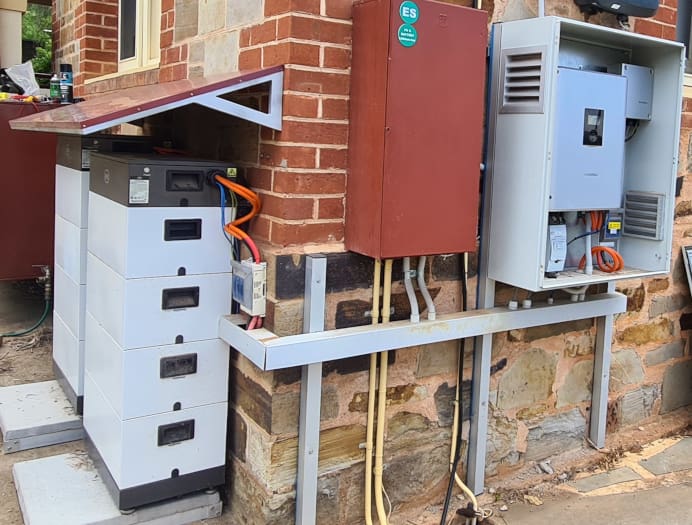
This early adopter started with a small Victron system, changed to Sungrow then expanded his 48V BYD battery stack with two more modules. It desperately needs a fan-forced enclosure so the door can go back on.
Winter Means Off-Grid Needs To Be Even Bigger
Whether you have “enough” solar or not, there will be some days or weeks across winter when there simply aren’t enough sun hours to give you full self sufficiency.
It’s why an off-grid solar and battery system needs to be four times bigger and more capable than a hybrid, and will always realistically have a backup generator, but that should be explained in the design too.
Luckily for the millions of Australians who remain on grid, mains power provides a cheaper, quieter, more reliable way to recharge your battery. As commercial-scale wind power becomes our mainstay, along with bulk solar energy, the cheapest power ever generated is now available at midday. So even in winter, a decent-sized battery offers value by charging from the grid.
If you have a small roof and a large appetite, retail deals offering low or zero-cost happy hour rates mean you can charge a battery for next to nothing and save yourself from being violated by peak pricing after 3pm.
However you need an inverter big enough to suck down enough power to fill your battery inside the limited time window.
So How Big A Battery Do You Need?
What sized battery is just right depends on a host of factors, from how much electricity you use, to when you use it, to what energy plan you’re on, to how much solar you have. The answer is different for every household: use our add battery calculator to find out, or if you are looking to get solar as well, then our solar and battery calculator should do the trick.

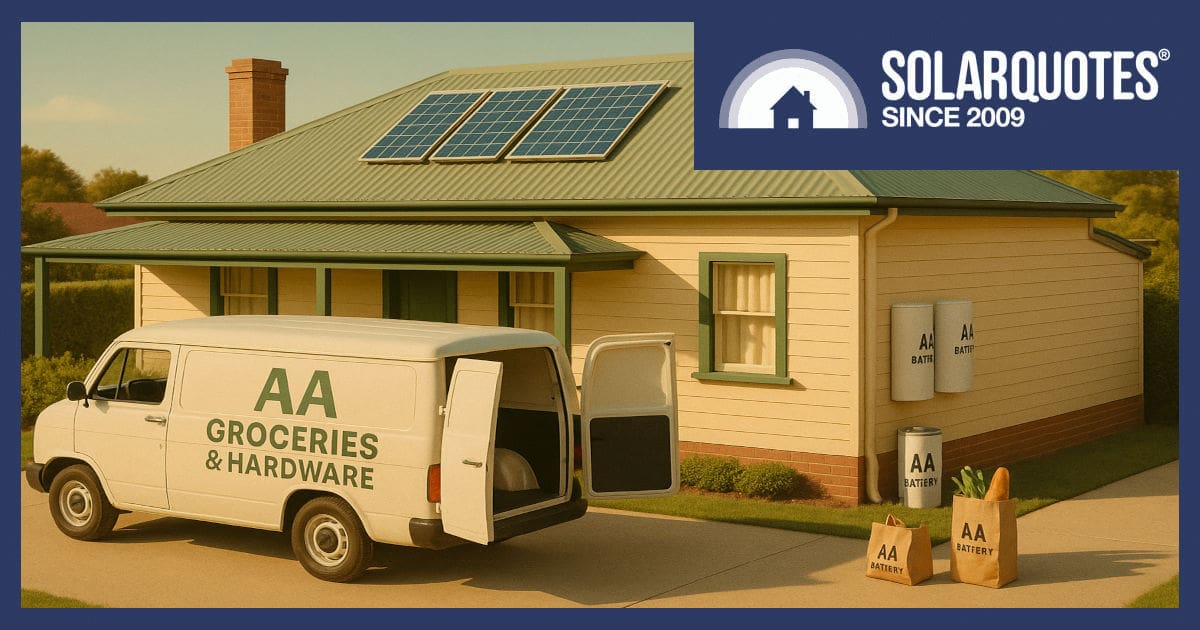
 RSS - Posts
RSS - Posts


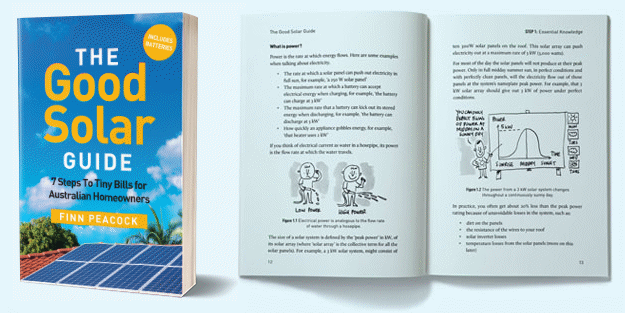
I reckon 10kWh plus 2 hours of whatever your export limit and/or inverter can move. Then go on wholesale (Amber) because that should be enough to never get caught out by a price spike. It doesn’t actually matter a lot how much solar you have (other than needing some to get in on the rebate) because battery-only is viable on its own now (in peakier priced states at least). Free stuff off the roof is just a bonus.
I always knew I was weird, but not that weird!
Our house ran on 4kWh per day for 10 Months of the year and 1kWh of that was inverter losses. (Fronius IG30) Two retirees.
Solar hot water helps and we were using the LPG hob a lot before getting some off grid batteries and off grid solar in late 2022.
But I have found our sub optimally angled off grid arrays and 8kWh of off grid batteries do struggle in Winter.
I got enthused enough by all the battery talk of late to lash out and get some more modules at 60% of the price I paid last time.
I understand this makes zero financial sense but this shouldl see our Annual grid take at less than 100kWh. And of course, exporting as much as we can for that juicy SA PFiT.
Anthony,
That box could also have a mesh panel in the door.
In my case (as an early adopter) I have 12Kw of Zenaji batteries. In a 7 person household with multi kitchens (& freezers!) we flatten our batteries virtually every night, but with Lithium Titanate that is not a problem (These are virtually Supercaps with Looong life, but expensive.) Unfortunately, I cannot upgrade because the Victron MP2´s are not in the current approval for upgrades. I think I will stay an Early Adopter, & get a bi-directional charger for my BYD Atto3. Then I can partially discharge the Zrnaji, using the rest for demand management, & the BYD for extra capacity, all controlled by Home Assistant.
Got a quote on one bi-EVSE, but think $9k is a bit XXXy (ie not sexy!). I might wait to see what ZJBeny releases: The firmware development release is on their website (if my interpretation of models is correct) so I feel it should be soon. I think $4>5K is what a basic DC bi-charger should cost.
Doug, another issue with the upgrade, if battery capacity is included, is that the current model Zenaji batteries are incompatible with the old version – run in parallel, you end up with breakers throwing repeatedly. (The bulk & float voltages don’t match, from memory.) Two separate banks, on two MP2s, might do the trick, but I haven’t seen GX firmware which will manage two battery banks.
My MG4’s limited range (320 km WLTP, 270 km of my highway driving) makes V2H unattractive here, out in the bush. (No trams for back-up) With a substantial home battery, I find it more convenient to raid that if needed to charge the BEV, then zoom into town with the home battery recharging while I’m mobile. That way, the EVCE runs flat out at 7.2 kW, gets the job done, and solar yield can catch up later – next day if necessary. (My take is that V2H is a temporary notion, soon to vanish as a nominal home battery goes from the current 20 kWh through 50 kWh inside a decade, as prices fall.)
I bit the bullet earlier this year before the Feds battery rebate came in. 20kWh Sungrow with a 5 kw Sungrow hybrid inverter. With 6.4 kw pvc
I also have a fronius string 5 kw plus 6.5 kw pvc.
Having 2 grid outages which I didn’t realise happened except for a sms from Endeavour.
Another advantage is having enough battery storage available to run my reverse air con in the early morning during winter.
I use a wood heater evenings night.
I am putting another 5kw battery on the existing stack and that will attract the fed rebate. Living in the country pumping rain water tank to the house is essential.
I would think a minimum 15 kwh battery is worth while also considering cloudy days where very little solar generation occurs.
Of course charging the battery from the grid when pricing is cheaper I have used on these continuously cloudy days.
3 and a half years ago I put in 2 solar systems on our duplex.
6.6kW/ 5kW inverter + a 4kWhr BYD battery on our side and a smaller system on the rental unit with no battery.
I was so impressed that a year later I decided to up grade both systems.
On our side I got a 9.99kW inverter and 12.5kW of solar installed and moved our original 6.6/5kw system over to the rental unit. To our original 4kWhr battery we added another 3 modules giving a total of 12kWhrs. To our Sungrow hybrid inverter we aded 4x modules of their high voltage batteries.
We have never runout of power even during days of overcast cloud cover.
We still manage to keep our EV charged and the old resistive hot water system hot and still make $’s from feed in which pays for our rates at the end of the year.
Thanks, Solar Quotes, love you guys.
Powering the HWS off batteries is nuts … but last night I did it accidentally. An amply sized battery meant there was still heaps of energy for RCAC heating and a coffee brew at 8 a.m.. The wood heater is great in the evening, but prior to a morning coffee having percolated in the bloodstream, I’m not mucking about setting and lighting a fire – which in any event takes an hour or two to do any good. The aircon is already warming on the outside while the hot coffee is doing its thing inside. And you don’t have to stoke it – not bad all round, really.
Incidentally, the extra physical energy that comes from getting out in the sun daily, suggests I’m partly solar powered too. Whether just extra vitamin D & exercise, it’s great for hauling out of the winter dip into greater Spring activity and good spirits.
“save yourself from being violated by peak pricing after 3pm…”
Just a reminder that there are major differences in peak time periods depending on supplier and retailer. For example, for Sydney, Red Energy currently charges peak rates from 2pm to 8pm every weekday of the year. This is very different to the Ausgrid wholesale periods.
More info at:
https://www.solarquotes.com.au/energy/
What’s the ideal solution for Western Australia (wait awhile) households as we don’t have the options for different suppliers/retailers. Its a monopoly and even though there are different plans there is no competition for ‘happy hour’ deals or differential rates. From what I understand from my research there is no ‘off peak’ period so makes no sense to charge a battery from grid.
In summary when there is plenty of sun for solar to charge the battery for afternoon/evening use (usually for cooktop/oven and a/c) it works, but in winter I don’t see there being enough sun/solar to run the household (a/c heating) and charge the battery for evening use.
Mark, I’m at 38°S, 6° closer to Antarctica than Perth, and 27 kW of PV charged my battery back to 100% by 9:00 this winter morning. The resistive HWS took until 1 p.m. for the thermostat to switch off, but that’s due to a modest 2.4 kW element in a 250L tank. There’s ample power here, but fully off-grid, so nowhere for it to go, as the EV is topped up too.
The 6-stars insulation means the small 3.5 kW (thermal) aircon doesn’t run continuously to maintain 24°C, using 600 – 700W part of the time. At 3 p.m., only 14.2 kWh consumed so far today.
The 15th was the last overcast day this winter month, where it took until midday to reach 100% SoC. I kept consumption to 9.5 kWh, out of weather caution, but the 46 kWh battery could run the aircon for several days, so it’s just for maximum reserve.
Do you have dawn to dusk deep dark overcast every day over there – no winter sunlight? If not, panels are cheap now. If grid limits are the problem, I’d probably off-grid HWS & aircon.
I reached out to AGL for a secondary battery to compliment my PW3 setup as soon as the Federal Government rebate was announced. I got a call (which I missed), returned it (3-4 times), and no response!
I’d love to upgrade the system if 27kw would mean I could go all night without sapping the grid (unfortunately the HVAC draws a bit even if it’s zoned).
I look forward to the day battery technology comes down in price and become an almost-consumable item!
Now I’ve been living off grid since the 1980’s and hold an automotive engineers qualification and environmental managment degree. My present house is an off grid 5.4 Kw solar with 8kw of battery storage and I survive with a Hot water system via an inverter heat pump and an EV. So how do my wife and I survive in the dead of winter. We live In a very sunny spot in south Australia, this is your most important consideration. Second we think about the next days solar potential. We don’t use the reverse cycle heating or hot water if a cloudy day is comming. And that’s it we light a wood fire for the evening before an over cast day. We have recently upgraded to 16 kw of storage and as such we haven’t had to light any wood fires this year. If you wish to operate without thought then get a massive battery, but if you have half a brain 10 kw will do in most situations, 15 Kw if you live in a hilly or otherwise cloudy area. Oh yes we only charge the EV on sunny days.
I’ve been trying to use the battery size calculator – after a false start, I entered the details for a Red Energy ‘time of use’ tariff that has summer & winter peaks (16:00 to 20:00) with off-peak rates applying at all other times. I’ve entered all the details including tariffs, supply charge, solar feed-in rate, etc, I can’t get the calculator to work any further – the “confirm” button is greyed out ! (as is the starting page next to the retailer details, so I can’t progress the exercise). Any thoughts on why the confirm button is greyed out ? (Also, having entered the data for Winter peak, I now can’t access the details I entered for Summer peak.). Many thanks for providing access to this type of model but I can’t understand what I’ve done wrong to make it freeze. [we have a 7.92 KW system comprising 18-panel Trina Vertex-S+ solar module with a Fronius Symo Gen24 non-hyrbrid inverter – installed at the end of April this year – the plan is to get a BYD battery box premium HVM 11kWh